
There are bits of information worth remembering, and others best outsourced to a handy reference. Preferably one that isn’t Wikipedia. Having a head crammed full of a broad swath of information is immensely handy in a shop with such wide-ranging activities. When an unexpected request comes through the door – and so many of them are unexpected – it’s refreshing to be able to approach the problem with at least some sense of which direction to take.
Even if you can’t pull up the specifics, knowing the outline of the process gets you started. A tiny dose of confidence helps, too. That and a willingness to give just about anything a shot. And, yeah, stuff gets broken sometimes.
Mental outlines are good. Instant recall of key facts is useful. Sometimes, though, you need a big table of numbers, because by the time you’ve committed that mountain of stuff to memory, you’ll have forgotten why you were even trying in the first place.
A big table, but not so big it won’t fit in a pocket. (Side note: you will always be happy to have a spare pocket around here.) Side A lists drill sizes with their diameters in millimeters (to 2 decimal places) and in inches (to 4 decimal places). Fractional from 1/64″ to 1″. Wire from 80 to 1. Letter from A to Z. Metric from 0.10mm to 25.5mm. 206 in total. (Assuming you consider 1/4″ and E to be separate drill sizes. They’re identical, save for the markings on the shaft.)
It’s especially helpful when trying to find just the right size for a project. That 1/4″ plastic tubing that needs to fit snugly-but-not-too-snugly? The 1/4″ drill probably won’t work. Size G, with a spare 0.28mm, might.

The B-side to this is a pair of tables that match up thread sizes – national coarse and fine; taper and straight pipe; metric – with the appropriate drill. The metric table even provides SAE alternatives should you find your metric drill selection somewhat less comprehensive than the full array of letters and wire numbers. Perhaps DoALL was more optimistic about an eventual shift to metric back in July of 1986.
Regardless, the table’s ease of converting between fractional inch, decimal inch, and millimeters is immensely useful in a shop where all three options might come into play. The availability of raw materials sometimes creates situations where you’ll work with both SAE and metric on the same job. It’s weird.
Honestly, here in the shop, we’d prefer to do everything in metric. Makes the mental math way easier.